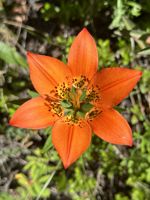Mon-Fri 9am - 5pm Mountain time
Pearly Everlasting vs Wood Lily
Lilium philadelphicum
Anaphalis margaritacea
CUSTOM GROW
CUSTOM GROW
Wood Lily is a native perennial wildflower known for its vibrant, trumpet-shaped blooms in shades of orange to red. Its showy flowers appear mid-summer and are highly visible in meadows and prairies. The upward-facing flowers are an important nectar source for many pollinators, including native bees, butterflies, and hummingbirds.
Unlike most lilies, the Wood Lily’s flowers face upward rather than nodding. It is slow to establish and may take years before flowering, but once mature, it requires little maintenance. It is well-suited for pollinator gardens, naturalisation projects, prairie restoration, and open woodland plantings.
Wood Lily is the provincial flower of Saskatchewan and North America’s most widespread lily. Despite its wide natural range, populations have been declining. Habitat loss, overgrazing by deer, and unsustainable picking have reduced both its abundance and density across many regions. These pressures highlight the importance of protecting and restoring this once-common wildflower.
Pearly Everlasting is a native perennial wildflower known for its clusters of white, papery flowers with yellow centres. These long-lasting blooms appear throughout summer, and the silver-grey foliage adds contrast to the landscape. Its nectar supports a variety of pollinators and serves as a host plant for painted lady caterpillars.
Pearly Everlasting is also used in dried flower arrangements. It is well-suited for pollinator gardens, naturalization, ecological restoration, and low-maintenance landscapes.
Wood Lily Quick Facts
Pearly Everlasting Quick Facts
Toxicity: toxic to cats

